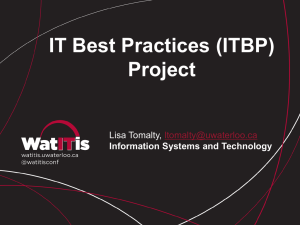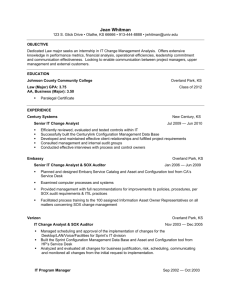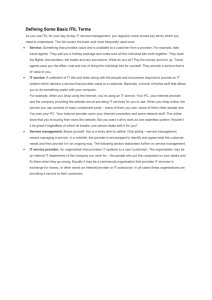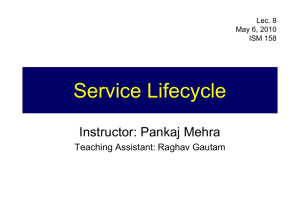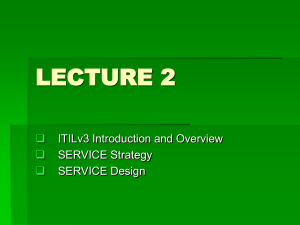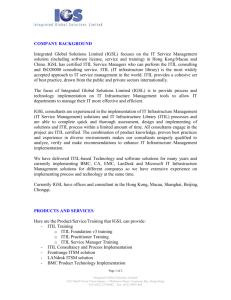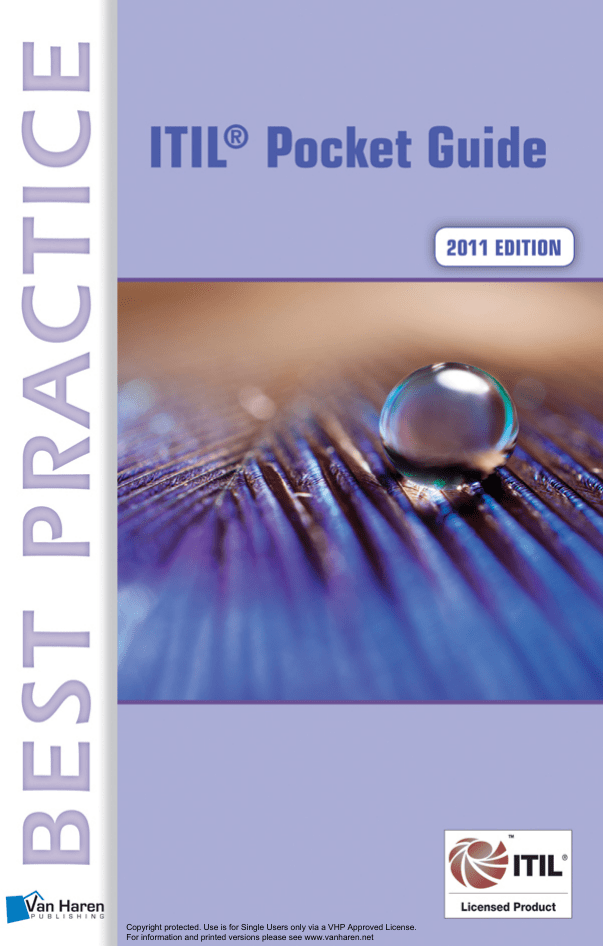
Copyright protected. Use is for Single Users only via a VHP Approved License.
For information and printed versions please see www.vanharen.net
ITIL ® 2011 Edition - A Pocket Guide
Copyright protected. Use is for Single Users only via a VHP Approved License.
For information and printed versions please see www.vanharen.net
Other publications by Van Haren Publishing
Van Haren Publishing (VHP) specializes in titles on Best Practices, methods and standards
within four domains:
- IT and IT Management
- Architecture (Enterprise and IT)
- Business Management and
- Project Management
Van Haren Publishing offers a wide collection of whitepapers, templates, free e-books, trainer
materials etc. in the Van Haren Publishing Knowledge Base: www.vanharen.net for more
details.
Van Haren Publishing is also publishing on behalf of leading organizations and companies:
ASLBiSL Foundation, CA, Centre Henri Tudor, Gaming Works, IACCM, IAOP, IPMA-NL,
ITSqc, NAF, Ngi, PMI-NL, PON, The Open Group, The SOX Institute.
Topics are (per domain):
IT and IT Management
ABC of ICT
ASL®
CATS CM®
CMMI®
COBIT®
e-CF
ISO 20000
ISO 27001/27002
ISPL
IT Service CMM
ITIL®
MOF
MSF
SABSA
Architecture
(Enterprise and IT)
Project, Program and Risk
Management
ArchiMate®
GEA®
Novius Architectuur Methode
TOGAF®
A4-Projectmanagement
DSDM/Atern
ICB / NCB
ISO 21500
MINCE®
M_o_R®
MSPTM
P3O®
PMBOK ® Guide
PRINCE2®
Business Management
BABOK ® Guide
BiSL®
EFQM
eSCM
IACCM
ISA-95
ISO 9000/9001
Novius B&IP
OPBOK
SAP
SixSigma
SOX
SqEME®
For the latest information on VHP publications, visit our website: www.vanharen.net.
Copyright protected. Use is for Single Users only via a VHP Approved License.
For information and printed versions please see www.vanharen.net
Licensed Product
ITIL® 2011 Edition A Pocket Guide
Copyright protected. Use is for Single Users only via a VHP Approved License.
For information and printed versions please see www.vanharen.net
Colophon
Title:
ITIL ® 2011 Edition - A Pocket Guide
Author:
Jan van Bon
Publisher:
Van Haren Publishing, Zaltbommel, www.vanharen.net
Design & layout: CO2 Premedia bv, Amersfoort – NL
ISBN Hard copy: 978 90 8753 676 3
ISBN eBook:
978 90 8753 925 2
ISBN ePUB:
978 90 8753 978 8
Edition:
First edition, fi rst impression, December 2011
First edition, second impression, March 2012
First edition, third impression, September 2012
First edition, fourth impression, April 2013
First edition, fi fth impression, December 2014
© 2011 Van Haren Publishing
All rights reserved. No part of this publication may be reproduced in any
form by print, photo print, microfi lm or any other means without written
permission by the publisher.
Although this publication has been composed with much care, neither
author, nor editor, nor publisher can accept any liability for damage
caused by possible errors and/or incompleteness in this publication.
© Crown copyright 2011. Reproduced under license from AXELOS:
cover diagram and diagrams 2.1, 3.1, 3.2, 4.1, 4.3, 4.4, 4.5, 4.6, 4.7, 4.8, 4.9,
5.1, 5.2, 5.3, 5.4, 5.5, 5.6, 5.7, 6.1, 6.2, 6.3, 6.4, 6.5, 6.6, 7.3
TRADEMARK NOTICES
ITIL ® is a registered trade mark of AXELOS.
The ITIL Swirl logo™ is a trade mark of AXELOS.
PRINCE2® is a registered trade mark of AXELOS.
COBIT ® is a registered trademark of the Information Systems Audit and
Control Association (ISACA)/IT Governance Institute (ITGI).
PMBOK® Guide is a registered trademark of the Project Management
Institute (PMI).
Copyright protected. Use is for Single Users only via a VHP Approved License.
For information and printed versions please see www.vanharen.net
Foreword
This concise summary offers a practical introduction to the
content of the five ITIL core books. It is based on ITIL 2011
Edition, and explains the structure of the service lifecycle,
and the processes and functions of each stage. It also provides
support for all the existing users of previous ITIL editions that
are looking for a bridge to the new edition.
The 2011 update resolved errors and inconsistencies, and
improved clarity, consistency, correctness, and completeness.
The Service Strategy book was revised in order to explain the
concepts in a clear, concise, and accessible way.
This pocket guide provides the reader with a quick reference
to the basic concepts of ITIL. Readers can use the Van Haren
Publishing publication “Foundations of ITIL” or the ITIL core
volumes (Service Strategy, Service Design, Service Transition,
Service Operation and Continual Service Improvement) for more
detailed understanding and guidance.
This pocket guide was produced in the same way as other
Van Haren Publishing publications: a broad team of expert
editors, expert authors and expert reviewers contributed to a
comprehensive text, and a great deal of effort was spent on the
development and review of the manuscript.
I’m convinced that this pocket guide will provide an excellent
reference tool for practitioners, students and others who want a
concise summary of the key ITIL concepts.
Jan van Bon
Copyright protected. Use is for Single Users only via a VHP Approved License.
For information and printed versions please see www.vanharen.net
6
ITIL® 2011 Edition - A Pocket Guide
Copyright protected. Use is for Single Users only via a VHP Approved License.
For information and printed versions please see www.vanharen.net
Acknowledgements
Following the official publication of ITIL, this pocket guide was
developed as a concise summary of the ITIL core books, by the
authors of the publication “Foundations of ITIL”. The text is
an update of the ITIL V3 Pocket Guide, that was produced by
the editors and reviewers of the ITIL Foundation publication.
All members of IPESC, itSMF International’s Publication
Committee, were invited to participate in the original review, and
thirteen itSMF chapters actively participated.
The integrated Review Team was composed of the following:
• Rob van der Burg, Microsoft, Netherlands
• Judith Cremers, Getronics PinkRoccade Educational
Services, Netherlands
• Dani Danyluk, Burntsand, itSMF Canada
• John Deland, Sierra Systems, itSMF Canada
• Robert Falkowitz, Concentric Circle Consulting, itSMF
Switzerland
• Karen Ferris, itSMF Australia
• Peter van Gijn, Logica, Netherlands
• Kevin Holland, NHS, UK
• Ton van der Hoogen, Tot Z Diensten BV, Netherlands
• Matiss Horodishtiano, Amdocs, itSMF Israel
• Wim Hoving, BHVB, Netherlands
• Brian Johnson, CA, USA
• Steve Mann, Opsys-sm2, itSMF Belgium
• Reiko Morita, Ability InterBusiness Solutions, Inc., Japan
• Ingrid Ouwerkerk, Getronics PinkRoccade Educational
Services, Netherlands
• Ton Sleutjes, Capgemini Academy, Netherlands
Copyright protected. Use is for Single Users only via a VHP Approved License.
For information and printed versions please see www.vanharen.net
8
ITIL® 2011 Edition - A Pocket Guide
• Maxime Sottini, iCONS – Innovative Consulting S.r.l., itSMF
Italy
The 2011 update of the ITIL pocket guide was reviewed by a
smaller section of this Review Team, since it only involved a
limited update:
• Rob van der Burg, Microsoft, Netherlands
• John Deland, Sierra Systems, itSMF Canada
• Peter van Gijn, Logica, Netherlands
• Kevin Holland, NHS, UK
• Steve Mann, Opsys-sm2, itSMF Belgium
• Reiko Morita, Ability InterBusiness Solutions, Inc., Japan
All reviewers spent their valuable hours on a detailed review of
the text, answering the core question “Is the content a correct
reflection of the core content of ITIL, given the limited size
of a pocket guide?”. Providing several hundreds of valuable
improvement issues, they contributed significantly to the quality
of this pocket guide, and we thank them for that.
Due to the expert services of the Review Team and the
professional support by the editors team, the resulting pocket
guide is an excellent entry into the core ITIL books. We are very
satisfied with the result, which will be of great value for people
wanting to get a fi rst high-level grasp of what ITIL is really all
about.
Copyright protected. Use is for Single Users only via a VHP Approved License.
For information and printed versions please see www.vanharen.net
Contents
1
1.1
1.2
1.3
1.4
1.5
Introduction
What is ITIL?
Why is ITIL successful?
ITIL exams
Structure of this pocket guide
How to use this pocket guide
13
13
14
14
16
16
2
2.1
2.2
2.3
2.4
2.5
2.6
2.7
2.8
2.9
Introduction to the service lifecycle
Defi nition of service management
Internal and external customers
Internal and external services
Overview of the service lifecycle
Functions and processes
Organizational structure
ITIL lifecycle clustering
The process model and the characteristics of processes
Key concepts
17
17
18
18
18
20
21
24
27
28
3
3.1
3.2
3.3
3.4
3.5
3.6
3.7
3.8
3.9
3.10
Lifecycle stage: service strategy
Introduction
Basic concepts
Processes and other activities
Strategy management for IT services
Service portfolio management
Financial management for IT services
Demand management
Business relationship management
Governance
Organization
39
39
39
41
42
43
47
56
59
61
62
Copyright protected. Use is for Single Users only via a VHP Approved License.
For information and printed versions please see www.vanharen.net
ITIL® 2011 Edition - A Pocket Guide
10
3.11 Methods, techniques and tools
3.12 Implementation and operation
63
64
4
4.1
4.2
4.3
4.4
4.5
4.6
4.7
4.8
4.9
4.10
4.11
4.12
4.13
4.14
4.15
Lifecycle stage: service design
Introduction
Basic concepts
Processes and other activities
Design coordination
Service catalogue management
Service level management
Availability management
Capacity management
IT service continuity management
Information security management
Supplier management
Service design technology-related activities
Organization
Methods, techniques and tools
Implementation and operation
69
69
69
72
74
76
78
82
86
88
91
94
98
102
102
102
5
5.1
5.2
5.3
5.4
5.5
5.6
5.7
5.8
5.9
5.10
5.11
Lifecycle stage: service transition
Introduction
Basic concepts
Processes and other activities
Transition planning and support
Change management
Service asset and configuration management
Release and deployment management
Service validation and testing
Change evaluation
Knowledge management
Organization
105
105
105
106
108
110
114
118
121
124
126
128
Copyright protected. Use is for Single Users only via a VHP Approved License.
For information and printed versions please see www.vanharen.net
Contents
11
5.12 Methods, techniques and tools
5.13 Implementation and operation
129
130
6
6.1
6.2
6.3
6.4
6.5
6.6
6.7
6.8
6.9
6.10
6.11
6.12
Lifecycle stage: service operation
Introduction
Basic concepts
Processes and other activities
Event management
Incident management
Request fulfi llment
Problem management
Access management
Common service operation activities
Organization
Methods, techniques and tools
Implementation and operation
133
133
133
135
136
140
143
147
151
154
161
166
167
7
7.1
7.2
7.3
7.4
7.5
7.6
7.7
Lifecycle stage: continual service improvement
Introduction
Basic concepts
Processes and other activities
Seven-step improvement process
Organization
Methods, techniques and tools
Implementation and operation
169
169
169
173
174
178
179
182
Acronyms
185
References
189
Copyright protected. Use is for Single Users only via a VHP Approved License.
For information and printed versions please see www.vanharen.net
12
ITIL® 2011 Edition - A Pocket Guide
Copyright protected. Use is for Single Users only via a VHP Approved License.
For information and printed versions please see www.vanharen.net
1 Introduction
This pocket guide provides the reader with an overview of the
basic concepts of ITIL (ITIL 2011 Edition). Readers can use
the publication “Foundations of ITIL” or the ITIL core volumes
(Service Strategy, Service Design, Service Transition, Service
Operation and Continual Service Improvement) for more
detailed understanding and guidance.
1.1
What is ITIL?
The Information Technology Infrastructure Library™ (ITIL)
offers a systematic approach to the delivery of quality IT services.
ITIL was developed in the 1980s and 1990s by CCTA (Central
Computer and Telecommunications Agency, now the Office
of Government Commerce, OGC), under contract to the UK
Government. Since then, ITIL has provided not only a best
practice based framework, but also an approach and philosophy
shared by the people who work with it in practice. ITIL has now
been updated three times, the fi rst time in 2000-2002 (V2), the
second time in 2007 (V3), and now in 2011. From 2011 onward,
new editions will be named by the year of their release (“ITIL
2011”).
Several organizations are involved in the maintenance of the best
practice documentation in ITIL:
• OGC (Offi ce of Government Commerce) – Owner of ITIL,
promoter of best practices in numerous areas including IT
service management.
• itSMF (IT Service Management Forum) – A global,
independent, internationally recognized not-for-profit
organization dedicated to support the development of IT
service management, e.g. through publications in the ITSM
Copyright protected. Use is for Single Users only via a VHP Approved License.
For information and printed versions please see www.vanharen.net
ITIL® 2011 Edition - A Pocket Guide
14
Library series. It consists of a growing number of national
chapters (40+), with itSMF International as the controlling
body.
• APM Group – In 2006, OGC contracted the management of
ITIL rights, the certification of ITIL exams and accreditation
of training organizations to the APM Group (APMG), a
commercial organization. APMG defi nes the certification and
accreditation schemes for the ITIL exams, and publishes the
associated certification system.
• Examination institutes – To support the world-wide delivery
of the ITIL exams, APMG has accredited a number of
exam bodies: BCS-ISEB, CERT-IT, CSME, DANSK IT,
DF Certifiering AB, EXIN, Loyalist Certification Services,
PEOPLECERT Group, and TÜV SÜD Akademie. See
www.itil-officialsite.com for recent information.
1.2
Why is ITIL successful?
ITIL combines a number of characteristics that makes it a
valuable and effective instrument, aiming at that one goal that
really counts: delivering value to the business. It is vendorneutral, making sure it is applicable to any IT organization,
whatever products are used. It is non-prescriptive, making sure
it can be adopted and adapted in organizations in any line of
business, be it public or private, internal or external, small or
large. And fi nally, it is best practice: it represents the lessons
of the best performing organizations in the IT service business
today.
1.3
ITIL exams
In 2007 the accreditor (APM Group) launched a new
qualification scheme for ITIL, based on ITIL V3. The ITIL V2
certification ceased in mid 2011. Candidates who hold existing
Copyright protected. Use is for Single Users only via a VHP Approved License.
For information and printed versions please see www.vanharen.net
1 Introduction
ITIL V3 certification will not need to become re-certified with
the ITIL 2011 update. The accreditor has no plans to introduce
any bridging examinations for the update, as the core ITIL
process areas and principles have not changed significantly.
ITIL V2 had qualifications on three levels:
• Foundation Certifi cate in IT Service Management
• Practitioner’s Certifi cate in IT Service Management
• Manager’s Certifi cate in IT Service Management
The ITIL V2 exams proved to be a great success. Up to 2000,
some 60,000 certificates had been issued. In the following years
the numbers rocketed, and by 2006 they had broken the 500,000
mark.
For ITIL V3 a new system of qualifications was set up. This also
applies to the ITIL 2011 edition. There are four qualification
levels:
• Foundation Level
• Intermediate Level (Lifecycle Stream & Capability Stream)
• ITIL Expert Level
• ITIL Master Qualification
Each of the service lifecycle stages requires appropriate skills
and experience of people involved, so they can work effectively
and efficiently throughout the lifecycle. Core skills, attributes and
competencies include business awareness, a basic understanding
of what IT can contribute to the business, customer service skills,
and the ability to work with best practice and policies. The Skills
Framework for the Information Age (SFIA) is often used as a
common reference model for IT organizations. SFIA defi nes a
standardized skills structure for tasks and core competencies.
Copyright protected. Use is for Single Users only via a VHP Approved License.
For information and printed versions please see www.vanharen.net
15
ITIL® 2011 Edition - A Pocket Guide
16
For more information about the ITIL qualification scheme, see
http://www.itil-officialsite.com/qualifications. More information
on SFIA can be found at www.sfia.org.uk
1.4
Structure of this pocket guide
Chapter 2 introduces the service lifecycle, in the context of IT
service management principles. It discusses the functions and
processes that are referred to in each of the lifecycle stages. It
provides general information on principles of processes, teams,
roles, functions, positions, tools, and other elements of interest.
It also shows how the processes, the common activities, and the
functions are clustered in the 5 ITIL core books.
In Chapters 3 to 7, each of the stages in the service lifecycle is
discussed in detail, following a standardized structure: service
strategy, service design, service transition, service operation and
continual service improvement. For each process and function,
the following information is provided:
• introduction
• basic concepts
• activities
1.5
How to use this pocket guide
Readers who are primarily interested in getting a quick
understanding of the service lifecycle can focus on the
introduction chapters of the pocket guide, and pick whatever they
need on specific functions and processes from the other chapters.
Copyright protected. Use is for Single Users only via a VHP Approved License.
For information and printed versions please see www.vanharen.net
2 Introduction to the
service lifecycle
2.1
Definition of service management
ITIL is presented as “best practice”. Best practice is an approach
or method that has been proven in practice. Best practices can be
a solid backing for organizations that want to improve their IT
services.
The ITIL service lifecycle is based on ITIL’s core concept of
“service management” and the related concepts “service” and
“value”. These core terms in service management are explained
as follows:
• Service management – A set of specialized organizational
capabilities for providing value to customers in the form of
services.
• Service – A means of delivering value to customers by
facilitating outcomes the customers want to achieve without
the ownership of specific costs or risks. Outcomes are possible
from the performance of tasks and they are limited by a
number of constraints. Services enhance performance and
reduce the pressure of constraints. This increases the chances
of the desired outcomes being realized.
• Value – Value is the core of the service concept. From the
customer’s perspective, value consists of two core components:
utility and warranty. Utility is what the customer receives,
and warranty is how it is provided. The concepts “utility” and
“warranty” are described in the Section on service strategy.
Copyright protected. Use is for Single Users only via a VHP Approved License.
For information and printed versions please see www.vanharen.net
ITIL® 2011 Edition - A Pocket Guide
18
2.2
Internal and external customers
Internal customers are people or departments who are part of
the same organization as the service provider. These customers
may be business units, departments, teams, or any other type of
organizational unit.
External customers are people who are not employed by the
organization, or organizations that are separate legal entities.
The agreements between a service provider and external
customers are legally binding contracts. External customers pay
with ‘real money’ (or goods).
Both internal and external customers must be provided with the
agreed level of service, with the same levels of customer service.
2.3
Internal and external services
There also are internal and external services. Internal services
are delivered to customers in the same organization. External
services are delivered to external customers.
2.4
Overview of the service lifecycle
ITIL approaches service management from the lifecycle aspect
of a service. The service lifecycle is an organizational model that
provides insight into:
• the way service management is structured
• the way the various lifecycle components are linked to each
other
• the impact that changes in one component will have on other
components and on the entire lifecycle system.
Thus, ITIL focuses on the service lifecycle, and the way service
management components are linked. Processes and functions are
also discussed in the lifecycle stages.
Copyright protected. Use is for Single Users only via a VHP Approved License.
For information and printed versions please see www.vanharen.net
2 Introduction to the service lifecycle
The service lifecycle consists of five stages. Each volume of the
new core ITIL volumes describes one of these stages. The related
processes are described in detail in the stage where they have the
strongest association.
The five stages (domains of the core books) are:
1. Service strategy – the stage that defi nes the requirements
for a service provider to be able to support the business
requirements. It describes the strategy of delivering and
managing services to the customer, in the perspective of
added value to the customer’s business.
2. Service design – the stage where services are designed,
and planned for introduction into the service delivery
environment. It includes several practices, making sure that
services are designed with the business objectives in mind.
3. Service transition – following up on service strategy and
service design stages of the lifecycle, the activities in this
stage ensure that service releases are deployed successfully
into supported environments, and that new, modified or
retired services meet the expectations of the business, while
controlling the risks of failure and subsequent disruption.
4. Service operation – this is the stage where the service provider
coordinates and carries out the activities and processes
required to deliver and manage services at agreed levels to
business users and customers.
5. Continual service improvement – the fi fth stage describes
best practice for achieving incremental and large-scale
improvements in service quality, operational efficiency and
business continuity, and for ensuring that the service portfolio
continues to be aligned to business needs.
Service strategy is the axis of the service lifecycle (Figure 2.1)
that drives all other stages; it is the stage of policymaking
Copyright protected. Use is for Single Users only via a VHP Approved License.
For information and printed versions please see www.vanharen.net
19
ITIL® 2011 Edition - A Pocket Guide
20
and setting objectives. The service design, service transition
and service operation stages are guided by this strategy; their
continual theme is adjustment and change. The continual
service improvement stage stands for learning and improving,
and embraces all other lifecycle stages. This stage initiates
improvement programs and projects, and prioritizes them based
on the strategic objectives of the organization.
Se
rv
tin
Con
ual Service Improvem
en
t
sign
De
e
c
i
Servic
tra
e Transition
tegy
ITIL 2011
Edition
ic
Serv
eS
Se
rvi
ce
Ope
ration
Figure 2.1 The service lifecycle
Source: AXELOS
2.5
Functions and processes
Each of the lifecycles describes a number of processes and a
number of functions. Processes and functions are defi ned as
follows:
• Process – A structured set of activities designed to accomplish
a defi ned objective. Processes have inputs and outputs,
result in a goal-oriented change, and utilize feedback for
Copyright protected. Use is for Single Users only via a VHP Approved License.
For information and printed versions please see www.vanharen.net
2 Introduction to the service lifecycle
self-enhancing and self-corrective actions. Processes are
measurable, provide results to customers or stakeholders,
are continual and iterative and are always originating
from a certain event. Processes can run through several
organizational units. An example of a process is change
management.
• Function – A team or group of people and the tools they use
to carry out one or more processes or activities, specialized
in fulfi lling a specified type of work, and responsible for
specific end results. Functions have their own practices and
their own knowledge body. Functions can make use of various
processes. An example of a function is a service desk. (Note:
“function” can also mean “functionality”, “functioning”,
or “job”.)
Processes are often described using procedures and work
instructions:
• A procedure is a specified way to carry out an activity or
a process. A procedure describes the “how”, and can also
describe “who” executes the activities. A procedure may
include stages from different processes. Procedures will vary
depending on the organization.
• A set of work instructions defi nes how one or more activities
in a procedure should be executed in detail, using technology
or other resources.
2.6
Organizational structure
When setting up an organization, positions and roles are also
used, in addition to the various groups (teams, departments,
divisions):
• Roles are sets of responsibilities, activities and authorities
granted to a person or team. One person or team may have
Copyright protected. Use is for Single Users only via a VHP Approved License.
For information and printed versions please see www.vanharen.net
21
22
ITIL® 2011 Edition - A Pocket Guide
multiple roles; for example, the roles of configuration manager
and change manager may be carried out by one person.
• Job positions are traditionally recognized as tasks and
responsibilities that are assigned to a specific person. A
person in a particular position has a clearly defi ned package
of tasks and responsibilities which may include various
roles. Positions can also be more broadly defi ned as a logical
concept that refers to the people and automated measures
that carry out a clearly defi ned process, an activity or a
combination of processes or activities. Individuals and roles
have an N:N relationship (many-to-many).
We can study each process separately to optimize its quality:
• The process owner is responsible for the process results.
• The process manager is responsible for the realization and
structure of the process, and reports to the process owner.
• The process practitioners are responsible for defi ned activities,
and these activities are reported to the process manager.
The management of the organization can provide control on
the basis of data from each process. In most cases, the relevant
performance indicators and standards will already be agreed
upon, and the process manager can take day-to-day control of
the process. The process owner will assess the results based on
performance indicators and check whether the results meet the
agreed standard. Without clear indicators, it would be difficult
for a process owner to determine whether the process is under
control, and if planned improvements are being implemented.
When setting up a service or a process, it is imperative that all
roles are clearly defi ned and that it is clear who does what. For
this purpose, a responsibility model like RACI can be used.
Copyright protected. Use is for Single Users only via a VHP Approved License.
For information and printed versions please see www.vanharen.net
2 Introduction to the service lifecycle
RACI provides an ‘authority matrix’ to defi ne the roles and
responsibilities in relation to processes and activities.
RACI is an acronym for the four main roles:
• Responsible – The person or people responsible for correct
execution – for getting the job done.
• Accountable – The person who has ownership of quality and
the end result. Only one person can be accountable for each
task.
• Consulted – The people who are consulted and whose
opinions are sought. They have involvement through input of
knowledge and information.
• Informed – The people who are kept up to date on progress.
They receive information about process execution and quality.
People, process, products and partners (the four Ps) provide the
main “machinery” of any organization, but they only work well
if the machine is oiled: communication is an essential element in
any organization. If the people do not know about the processes
or use the wrong instructions or tools, the outputs may not be as
anticipated. Formal structures on communication include:
• Reporting – Internal and external reporting, aimed at
management or customers, project progress reports, alerts.
• Meetings – Formal project meetings, regular meetings with
specific targets.
• Online facilities – Email systems, chat rooms, pagers,
groupware, document sharing systems, messenger facilities,
teleconferencing and virtual meeting facilities.
• Notice boards – Near the coffee maker, at the entrance of the
building, in the company restaurant.
Copyright protected. Use is for Single Users only via a VHP Approved License.
For information and printed versions please see www.vanharen.net
23



